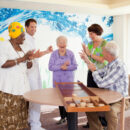Understanding the Emotional Side of the Senior Living Decision
Moving into senior living is more than a change of address. It is a transition that affects identity, independence, and family connections. This guide covers common fears, ways to preserve dignity, and strategies to ease adjustment. Whether you are planning ahead or navigating the move now, you will learn how to support your loved one and yourself with clarity and confidence.

Any big move is an emotional transition, as is the nature of change, but choosing a senior living community isn’t just going from one house to another. It’s a life transition, and it should honor a lifetime of memories, preserve dignity, and support both emotional and physical well-being. For many families, the decision brings a wave of emotions: uncertainty, relief, guilt, hope. At Koelsch Communities, we recognize the emotional side of senior living and offer guidance rooted in compassion, respect, and over 60 years of experience.
Whether you’re just beginning the decision-making process or actively planning a transition for a loved one, this article will help you understand what to expect emotionally and how to move forward with confidence.
Why the Emotional Side Matters
It’s More Than a Lifestyle Change
This decision touches on identity, autonomy, and family roles. Seniors may be leaving behind a home filled with decades of memories, while adult children may be stepping into new caregiving responsibilities. These are life-shaping moments, and the emotional aspects of the transition deserve just as much attention as the practical ones.
The Emotional Ties to Home and Independence
Home is a sense of self and a connection to community, not just a physical space. Letting go of familiar surroundings can feel like letting go of independence. Even when assisted living or memory care offers a safer and more enriching life, it can take time to see it that way.
Common Emotional Responses in Senior Living Decisions
Fear of Losing Independence
Seniors often worry about losing control over their daily routines. However, this fear is not based on reality, and communities that offer flexible schedules, privacy, and choices in daily living can help to ease it.
Guilt and Uncertainty Among Family Members
Adult children may feel guilty about encouraging a move, even when it’s the right decision. That guilt often comes from love, not logic, and it’s important to recognize that taking care of yourself and supporting a higher quality of life for your loved one is an act of compassion.
Resistance to Change
Even when a senior living community offers warmth, safety, and social connection, change can feel threatening. Understanding this resistance as a natural emotional response helps ease tension and create empathy during conversations.
The Three Common Emotional Processes
Most families and residents go through a cycle of emotions before, during, and after a move.
Denial: “I’m Not Ready Yet”
This stage often includes resistance or dismissal of options. Gentle, consistent conversations help break through this phase.
Grief: Letting Go of the Familiar
Even if the move is welcomed, there’s often grief involved, whether it’s grief over lost routines, beloved neighbors, or personal items that won’t come along. It’s natural to mourn these changes. One effective way to ease this grief is to create a space for treasured items in the new apartment or suite. This could include framed photos, favorite books, treasured heirlooms, or even a small display of meaningful objects that represent life chapters. This simple gesture affirms that their past is still present and still honored.
Acceptance: Moving Toward Peace and Belonging
As seniors begin to connect with staff members and fellow residents, their new surroundings start to feel like home. This is when confidence in the decision begins to solidify, and the period of emotional strain might begin to ease. Remember, there is no official timetable or formula for the emotional transition, and every journey into senior living is a unique one. Do not lose hope if acceptance is a long time in coming; good things take time, and unease with change is perfectly natural.
What Families Often Feel and Why
Adult Children
You’re not alone if you feel conflicted. Many adult children juggle full-time jobs, parenting responsibilities, and caring for their aging parents. Moving into assisted living isn’t “giving up,” it’s partnering with professionals to ensure the finest living experience.
Spouses and Siblings
Spouses may struggle with a sense of separation or loss, especially if they remain in the original home. Siblings may have different perspectives on what’s best, leading to disagreement. Clear communication and shared goals can help unite the family.
How to Talk About the Transition with Empathy
What to Say to Someone Moving into Senior Living
The words we choose during emotional conversations can either open hearts or close doors. When discussing a move to assisted living, it’s important to use language that emphasizes respect, safety, and partnership. Gentle, supportive phrases help reduce anxiety and create a sense of shared purpose. They reassure your loved one that this isn’t something happening to them, it’s something you’re both navigating together. Here are a few examples of compassionate language that can help ease the conversation:
- “I want you to feel safe and cared for every day.”
- “We want to find a place where you can thrive, not just get by.”
- “Let’s explore what your options are together.”
Language That Builds Trust, Not Fear
Language matters. The way we orchestrate conversations can influence how open a loved one is to the idea of moving. Use “community” instead of “facility.” Use “ladies and gentlemen” to honor residents’ dignity. Frame the move as an opportunity, not a loss.
Tips for Starting the Conversation Early
Starting the conversation before a crisis occurs can make the transition feel less urgent and more thoughtful. Begin by asking open-ended questions like, “What would make life feel easier or more enjoyable right now?” This allows your loved one to reflect on their needs and preferences without feeling pressured. Visiting a few senior living communities together can also help replace uncertainty with familiarity, offering a clearer sense of what daily life could look like and opening the door for a shared decision-making process.
How Long Does It Take to Emotionally Adjust to Senior Living?
Adjustment periods vary from person to person, but most residents begin to feel more comfortable within a few weeks to three months. Frequent visits from family members can offer reassurance and familiarity, easing the transition, and seniors who participate in social activities early on often quickly form connections that create a stronger sense of belonging. Plus, compassionate support from staff members, who take the time to understand each resident’s preferences and personality, can make all the difference in creating a smooth adjustment.
Signs Your Loved One Is Settling In
As residents adjust, their behavior and engagement begin to shift in noticeable ways. They begin to form friendships with neighbors and look forward to communal meals or events. Conversations begin to center more on what’s happening today rather than dwelling on what was left behind.
Practical Ways to Ease the Emotional Transition
Involving Loved Ones in the Decision-Making Process
Empowering your loved one throughout the transition can make all the difference. Make sure to involve them in the process, perhaps by touring communities together and letting them take an active role in selecting their new apartment, arranging the furniture, or choosing which favorite belongings to bring. This involvement helps maintain dignity and control.
Downsizing Without Emotional Overload
When it comes to downsizing, it’s important to start small. Try focusing on just one room at a time, and encourage your loved one to prioritize items that bring joy or have deep meaning rather than simply what fits. Be mindful that many belongings carry stories, and making space for those stories to be shared can offer emotional release and a sense of continuity.
Visiting and Staying Connected After the Move
Consistent connection can ease the transition and reinforce a sense of security. Regular visits, especially during the first month, provide familiarity and comfort. Small gestures, like having grandchildren send letters or arranging weekly video chats, can go a long way in maintaining strong emotional bonds. Attending community events together also helps your loved one feel included and supported as they begin to form new connections and routines in their new environment.
When Emotions Become Barriers: Knowing When to Seek Help
While emotional ups and downs are natural during a transition, certain behaviors may signal deeper challenges. If your loved one is showing prolonged sadness, isolating themselves, or losing interest in daily life, it could point to depression or unresolved grief. These feelings often stem from a sense of loss, fear of change, or feeling disconnected in their new environment.
Agitation, aggression, or refusing meals may also be signs that your loved one is struggling to cope. These reactions can result from emotional stress, confusion, or, in memory care situations, cognitive changes. Left unaddressed, these issues can affect both well-being and quality of life.
Support is available. Geriatric counselors, local senior centers, and family support groups offer practical help and shared understanding. Many of these services can be accessed through your Koelsch community’s care team. Speak with the community director or wellness staff—they can guide you toward the right internal or external resources to support your loved one’s emotional health.
Building Confidence through Community
Life in a senior living community can open the door to renewed purpose and engagement, especially after a period of isolation or routine. Shared meals, group outings, and even hobbies can build new friendships naturally, growing a deeper sense of connection. Community events and programs bring residents together with their design for a wide range of interests. Many also discover a sense of purpose by contributing to community life by mentoring others, welcoming new residents, or participating in resident councils and committees. These opportunities not only support emotional well-being but also foster a sense of belonging and meaning that can be deeply fulfilling.
Questions Families Ask During the Transition
“Are we doing the right thing?”
Yes. When the goal is to enhance safety, connection, and quality of life, finding a new place for your loved one is a decision made with love. Choosing a senior living community isn’t about stepping away; it’s about stepping into a new kind of support. It means entrusting your loved one to a team of professionals who not only understand their needs but honor their dignity every single day. And it allows you, as a family member, to return to your most meaningful role: not as nurse or scheduler, but as daughter, son, partner, or friend.
“What will their day-to-day look like?”
Each day in a Koelsch community brings a comforting rhythm and meaningful moments. Mornings often begin with a warm cup of coffee and quiet conversation among neighbors who feel like old friends. Later, residents might join a creative workshop or try something new, like a cooking demo or a music session. In the afternoon, small walking groups enjoy the garden paths, sharing stories and laughter as they stroll. Daily experience here isn’t a routine; it’s just life.
“Will they feel at home?”
Our communities are built around that very question. With personalized care and a deep respect for individuality, our residents don’t just reside here. They belong.
About Koelsch Communities
Family-run since 1985, Koelsch Communities’ “Mom-approved” senior living options are designed with enjoyment, dignity, and fulfillment in mind. With over six decades of experience, we’ve created communities where Ladies and Gentlemen are treated with the respect and attention they deserve. From independent living to assisted living and memory care, every detail is crafted to support a lifestyle worth living.
Our team is dedicated to providing community-driven care that promotes well-being and a true sense of belonging. With a reputation for excellence and a timeless commitment to service, Koelsch Communities continues to lead with heart, ensuring that each resident feels valued, known, and at home.
To learn more about our senior living communities or to speak with someone who can guide you through the journey, we invite you to connect with us today. We’re here to help you find the support, peace of mind, and quality of life you and your loved ones deserve.
Disclaimer: This article is intended for informational purposes only and should not be considered medical, legal, or financial advice. Please consult with the appropriate professionals regarding your unique situation.









